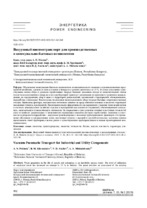| dc.contributor.author | Пехота, А. Н. | |
| dc.contributor.author | Хрусталев, Б. М. | |
| dc.contributor.author | Акельев, В. Д. | |
| dc.contributor.author | Михальченко, А. А. | |
| dc.coverage.spatial | Минск | ru |
| dc.date.accessioned | 2021-04-08T07:16:52Z | |
| dc.date.available | 2021-04-08T07:16:52Z | |
| dc.date.issued | 2021 | |
| dc.identifier.citation | Вакуумный пневмотранспорт для производственных и коммунально-бытовых компонентов = Vacuum Pneumatic Transport for Industrial and Utility Components / А. Н. Пехота [и др.] // Наука и техника. – 2021. – № 2. – С. 142-149. | ru |
| dc.identifier.uri | https://rep.bntu.by/handle/data/90017 | |
| dc.description.abstract | Образование коммунально-бытовых компонентов жизнедеятельности человека и производственных предприятий неизбежно, уровень их использования в Беларуси в среднем увеличился до 23 %. В статье дана оценка существующих систем сбора и удаления отработанных твердых бытовых элементов исходя из технологических этапов (подготовка компонентов к погрузке в мусороуборочный транспорт; организация их временного хранения в домовладениях, на предприятиях; сбор и вывоз с территорий домовладений, организаций и предприятий; обезвреживание, переработка, утилизация). Рассмотрены последствия несвоевременного сбора твердых бытовых и производственных отходов. Приведены факторы, оказывающие негативное влияние на среду обитания человека и экологию территорий населенных пунктов, предприятий. Представлен анализ эффективности своевременного удаления таких компонентов в системах коммунального хозяйства городов и предприятий как важной составляющей, обеспечивающей социальную, экономическую и экологическую значимость. На современном этапе развития техники и доступных технологий один из наиболее рациональных и экономически оправданных способов доставки отработанных элементов к участкам их сортировки и переработки – вакуумная транспортировка с помощью трубопроводного транспорта. Его применение обосновано в промышленных зонах, населенных пунктах с высокой и средней плотностью заселения, причем прокладывать такой трубопровод можно рядом с существующими трубопроводными и иными транспортными коммуникациями. | ru |
| dc.language.iso | ru | ru |
| dc.publisher | БНТУ | ru |
| dc.title | Вакуумный пневмотранспорт для производственных и коммунально-бытовых компонентов | ru |
| dc.title.alternative | Vacuum Pneumatic Transport for Industrial and Utility Components | ru |
| dc.type | Article | ru |
| dc.identifier.doi | 10.21122/2227-1031-2021-20-2-142-149 | |
| local.description.annotation | Waste generation in the life of people and enterprises is an inevitable process today. The level of utilization of municipal waste has increased on average to 23 % in Belarus. The paper provides an assessment of the existing systems for the collection and disposal of waste solid household items based on technological stages (preparation of waste for loading into a garbage collection vehicle; organization of temporary storage of waste in households, at enterprises; collection and removal of waste from the territories of households, organizations and enterprises; neutralization, processing and recycling of waste). The consequences of untimely collection of solid household and industrial waste are considered in the paper. The paper presents the factors that have a harmful effect on the human environment and the ecology of the territories of settlements and enterprises. An analysis of the effectiveness of the timely removal of such components in the systems of municipal services of cities and enterprises as an important component providing social, economic and environmental significance is given in the paper. At the present stage of the development of technology and available technologies, one of the most rational and economically justified ways of delivering waste to the areas for their sorting and processing is vacuum transportation using pipeline transport. Its application is justified for industrial zones and settlements with high and medium population density. Moreover, such a pipeline can be laid next to existing pipeline and other transport communications. | ru |

